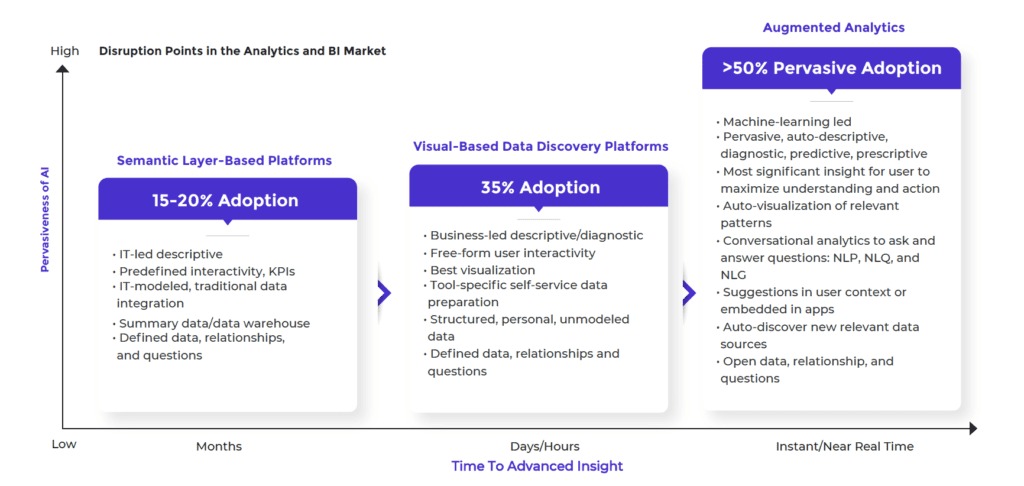The Future of Data Analysis: Harnessing the Power of Augmented Analytics
 Tellius Usa
Tellius Usa
As data continues to proliferate at unprecedented rates, the challenge of extracting actionable insights becomes ever more complex. Traditional analytics methods, while powerful, often fall short of delivering timely and comprehensive insights. Enter augmented analytics—a transformative approach that leverages advanced technologies like artificial intelligence (AI) and machine learning (ML) to enhance and automate data analysis.
What is Augmented Analytics?
Augmented analytics is an advanced form of data analytics that uses AI and ML to automate data preparation, insight discovery, and sharing. It integrates these advanced technologies with traditional analytics to streamline the process of deriving insights from data. By automating repetitive tasks and providing intelligent insights, augmented analytics empowers users to make more informed decisions faster and with greater accuracy.

Benefits of Augmented Analytics
Automated Data Preparation
Data preparation is often one of the most time-consuming aspects of data analysis. It involves cleaning, transforming, and integrating data from various sources to ensure it is ready for analysis. Augmented analytics automates much of this process, reducing the time and effort required to prepare data. This allows analysts to focus more on interpreting results and making strategic decisions.
Enhanced Insight Discovery
Traditional analytics relies heavily on the user's ability to ask the right questions and interpret data correctly. Augmented analytics, however, leverages AI and ML to automatically identify patterns, trends, and anomalies in the data. This capability enables the discovery of insights that might be missed by human analysts, leading to more comprehensive and accurate analysis.
Improved Decision-Making
By providing timely and relevant insights, augmented analytics enhances decision-making processes across the organization. Business users can access insights quickly, allowing them to respond to market changes and operational issues more effectively. The ability to make data-driven decisions in real-time can significantly improve business outcomes and competitiveness.
Increased Accessibility
One of the key advantages of augmented analytics is its ability to make data analysis accessible to a broader audience. Non-technical users can leverage intuitive interfaces and natural language processing (NLP) to interact with data and gain insights without needing advanced analytical skills. This democratization of data empowers employees at all levels to contribute to data-driven initiatives.
Scalability and Efficiency
Augmented analytics platforms are designed to handle large volumes of data efficiently. They can scale to meet the growing data needs of organizations, ensuring that analytics capabilities keep pace with data growth. This scalability, combined with the automation of complex tasks, results in significant efficiency gains and cost savings.
Implementing Augmented Analytics
Choose the Right Platform
Selecting the appropriate augmented analytics platform is crucial. Look for solutions that offer robust AI and ML capabilities, user-friendly interfaces, and seamless integration with existing data sources. Some popular platforms include Tableau, Qlik, Power BI, and Looker. Evaluate the features, ease of use, and scalability of each platform to determine the best fit for your organization.
Integrate Data Sources
For augmented analytics to be effective, it is essential to integrate all relevant data sources. This ensures a comprehensive view of the business and allows the platform to analyze data from various perspectives. Invest in data integration tools and practices to streamline this process and maintain data quality.
Train Users and Promote Adoption
Even though augmented analytics is designed to be user-friendly, providing training and support is essential for maximizing its potential. Offer training sessions to help users understand how to leverage the platform's capabilities effectively. Promote the adoption of augmented analytics by demonstrating its value through success stories and showcasing its impact on decision-making.
Foster a Data-Driven Culture
To fully realize the benefits of augmented analytics, organizations must foster a data-driven culture. Encourage employees to rely on data for decision-making and highlight the importance of data-driven insights. By creating an environment that values data, organizations can ensure that augmented analytics becomes an integral part of their operations.
Augmented analytics is revolutionizing the field of data analysis by leveraging AI and ML to enhance and automate the process of deriving insights from data. By automating data preparation, improving insight discovery, enhancing decision-making, increasing accessibility, and offering scalability, augmented analytics empowers organizations to make more informed and timely decisions.
Subscribe to my newsletter
Read articles from Tellius Usa directly inside your inbox. Subscribe to the newsletter, and don't miss out.
Written by
